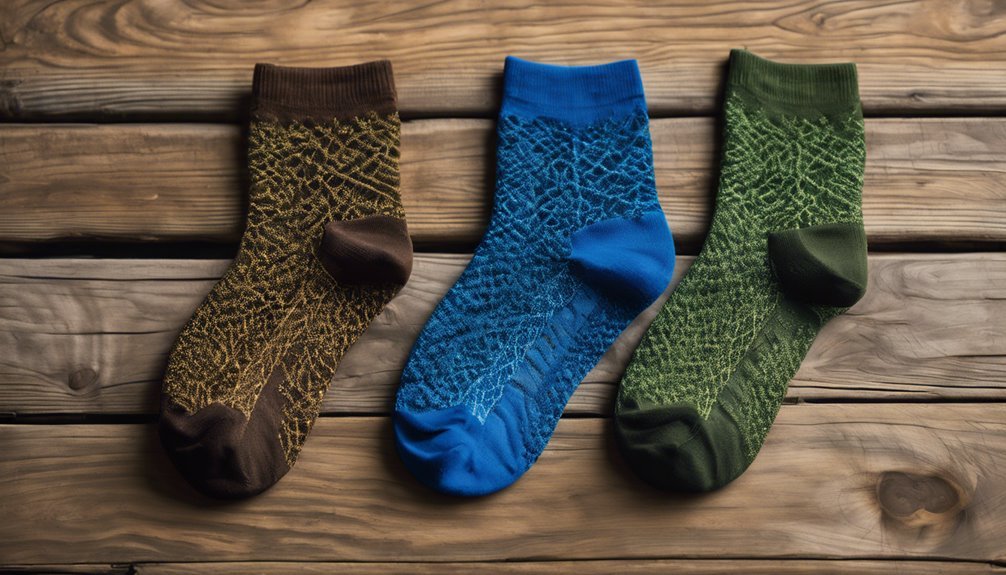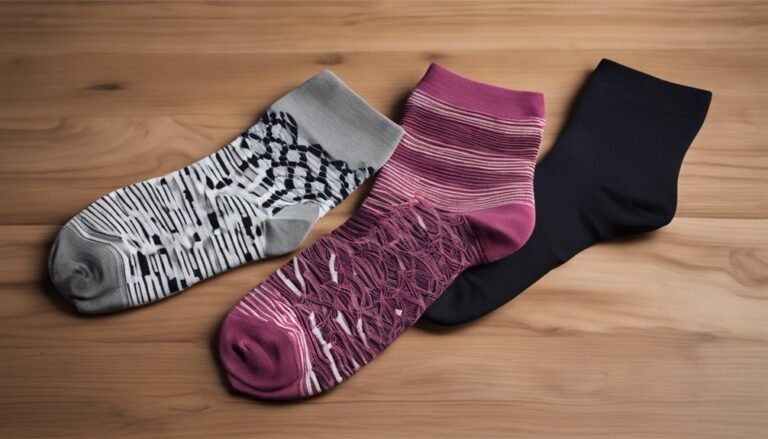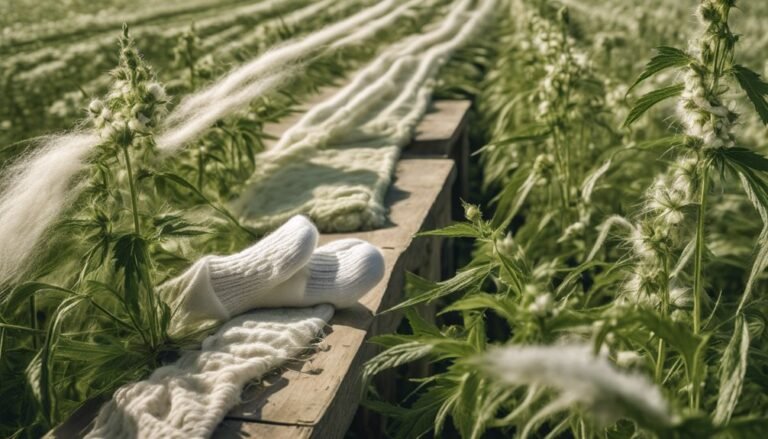Running Socks vs. Hiking Socks: What’s the Difference?
Running socks are designed for high-impact activities, focusing on moisture management and a snug fit to minimize friction. In contrast, hiking socks offer thicker cushioning for varied terrains and emphasize insulation and durability. You'll find running socks made from lighter, moisture-wicking fabrics, while hiking socks often feature merino wool blends for warmth and support. Understanding these differences can greatly enhance your comfort and performance during each activity. There's plenty more to uncover about finding the right sock for your needs.
Purpose and Activity Levels
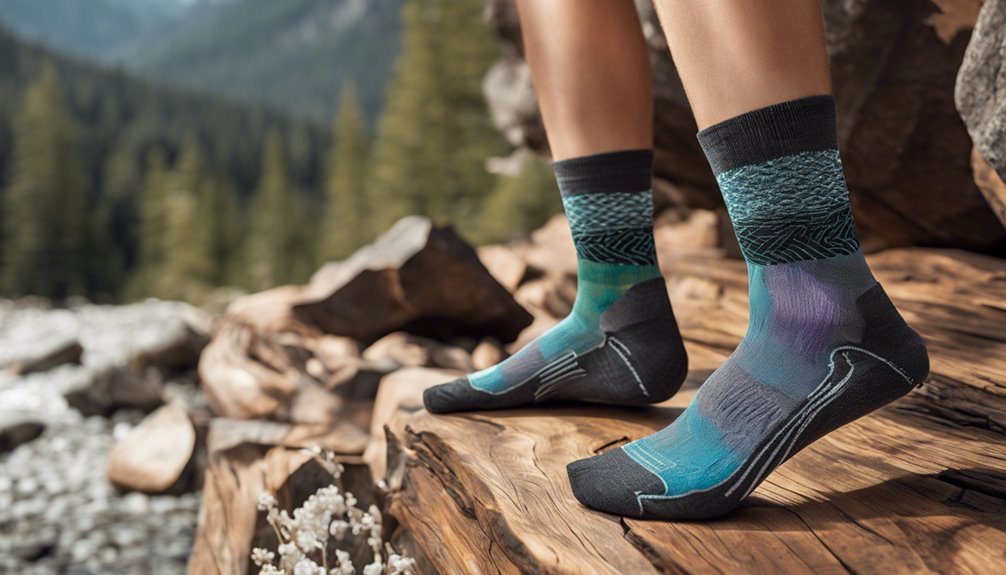
Whether you're hitting the pavement for a quick run or tackling a rugged trail, understanding the purpose and activity levels of running socks versus hiking socks can make a significant difference in your overall experience. Running socks are designed for high-impact activities in running environments, focusing on moisture management and breathability to keep your feet dry and blister-free. They often have a snug fit to enhance movement and minimize friction. On the other hand, hiking socks are built to withstand the challenges of varied hiking terrains, offering cushioning and support for long distances. They usually feature a thicker fabric for added warmth and protection against rough surfaces. Choosing the right sock for your activity can elevate your comfort and performance.
Material Composition
When choosing between running and hiking socks, understanding the material composition is essential. You'll find that running socks often use lighter, moisture-wicking fabrics like polyester or nylon, aimed at keeping your feet dry and comfortable during intense activities. In contrast, hiking socks typically feature thicker, more durable materials like merino wool, designed to withstand rough terrains while providing insulation and cushioning for long treks.
Fabric Types Used
While both running socks and hiking socks may seem similar at first glance, the fabric types used in each are specifically designed to cater to the unique demands of their respective activities. Running socks often utilize synthetic blends, like polyester and nylon, which provide lightweight support and quick-drying fabric benefits. These materials help you maintain speed and comfort on the go. On the other hand, hiking socks typically incorporate wool or thicker fabric blends, offering insulation and cushioning for long treks. The natural properties of wool keep your feet warm, even when wet, while also providing odor resistance. Choosing the right fabric type can greatly enhance your experience, ensuring you stay focused on your adventure, whether you're racing or rambling through nature.
Moisture-Wicking Properties
Understanding the moisture-wicking properties of socks is essential for optimizing your performance in both running and hiking. You want socks that excel in moisture management, ensuring that sweat absorption isn't a problem. Look for materials like merino wool, polyester, or nylon blends, as they effectively pull moisture away from your skin. This keeps your feet dry, reducing the risk of blisters and enhancing comfort during long runs or hikes. A good pair of socks will also provide breathability, allowing air circulation to help evaporate any trapped moisture. When you prioritize these properties, you're setting yourself up for a more enjoyable experience outdoors, letting you focus on your adventure instead of discomfort.
Durability and Longevity
Choosing the right material composition is essential for ensuring the durability and longevity of your running or hiking socks. High-quality blends, like merino wool and synthetic fibers, can greatly extend sock lifespan, offering both comfort and resilience. Merino wool is naturally durable, while synthetic materials often enhance moisture-wicking and drying properties.
For those who love freedom on the trails, understanding repair techniques can also help prolong your socks' life. Simple methods like darning or patching can salvage small holes, keeping your favorite pairs in rotation. Remember, investing in durable materials not only enhances performance but also reduces waste, allowing you to enjoy your adventures without the constant need for replacements. Choose wisely, and your socks will serve you well for many miles.
Cushioning and Support
When it comes to cushioning and support, the differences between running socks and hiking socks can greatly impact your comfort and performance. Running socks often incorporate advanced cushioning technology designed to absorb impact and enhance your stride, promoting a more efficient run. They typically feature targeted padding in key areas like the heel and ball of the foot, providing just enough support for dynamic movement.
On the other hand, hiking socks prioritize support systems that cater to the rugged terrain. They offer thicker cushioning throughout to protect your feet from the demands of uneven surfaces, reducing fatigue on long hikes. Choosing the right sock based on your activity guarantees you'll enjoy every step, whether you're sprinting or trekking through the wilderness.
Moisture-Wicking Properties
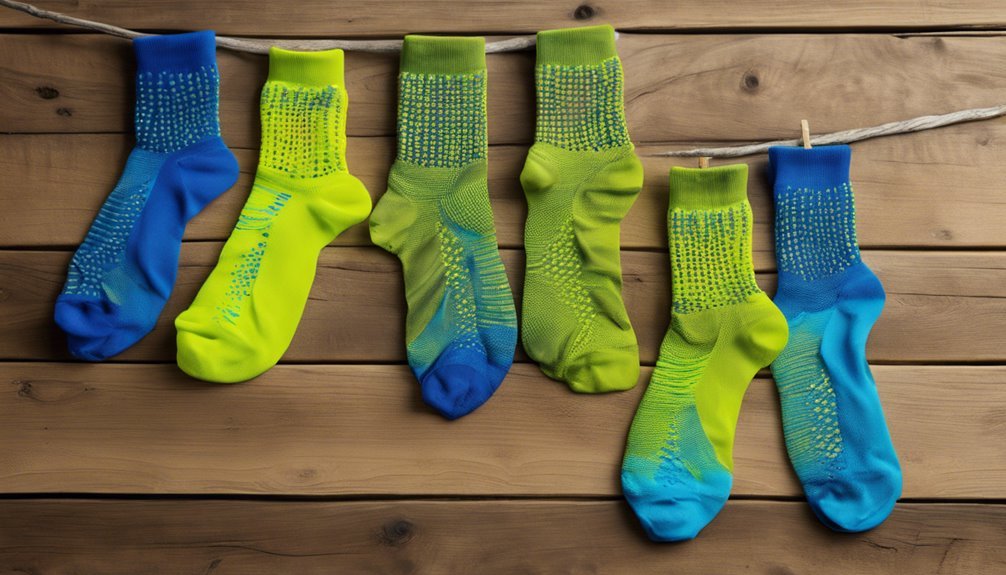
Both running and hiking can put your feet through the wringer, making moisture-wicking properties a key factor in sock selection. You want socks that excel in moisture management, allowing sweat to evaporate quickly, keeping your feet dry and comfortable. Running socks often use synthetic materials like polyester or nylon that pull moisture away from your skin, reducing the risk of blisters. Hiking socks may incorporate wool blends for additional insulation but should still prioritize sweat evaporation to prevent dampness on long treks. Choosing the right sock with effective moisture-wicking capabilities helps you stay focused on your adventure, letting you enjoy the freedom of movement without the distraction of wet, uncomfortable feet. Remember, dry feet equal happier outings!
Fit and Compression
When choosing between running and hiking socks, the fit and compression levels are essential for performance and comfort. Running socks typically have a snugger fit and may feature varying compression levels to enhance blood circulation, while hiking socks often prioritize cushioning and support with a looser fit. Understanding these structural differences can help you select the right socks for your specific activities.
Sock Structure Variations
Although the choice between running socks and hiking socks may seem straightforward, the variations in sock structure, particularly in fit and compression, play an essential role in your comfort and performance. Here's what to take into account:
- Sock Thickness Variations: Running socks tend to be thinner for breathability, while hiking socks are often thicker for cushioning.
- Seam Construction Differences: Running socks usually have flat seams to minimize irritation, whereas hiking socks may feature reinforced seams for durability.
- Fit: Running socks often have a snug fit to prevent slipping, while hiking socks might offer a looser fit for all-day wear.
- Compression: Some running socks provide targeted compression, enhancing circulation and support, which is less common in hiking socks.
Choosing the right sock structure can greatly enhance your outdoor experience.
Compression Levels Explained
Understanding compression levels in socks is essential for optimizing your performance and comfort during activities like running and hiking. Compression socks come in various styles, each offering unique compression benefits. Generally, lighter compression (15-20 mmHg) is ideal for everyday wear or light activities, enhancing blood circulation without restricting movement. Medium compression (20-30 mmHg) is great for runners, as it helps reduce muscle fatigue and supports recovery. High compression (above 30 mmHg) is often used for medical purposes or intense athletic training, providing maximum support. When choosing, consider the fit that feels right for your feet. The right compression style can make a significant difference, allowing you to enjoy your adventures with greater freedom and less fatigue.
Length and Design Options
While you might think all socks are created equal, running and hiking socks come in various lengths and designs tailored to their specific activities. Understanding these options can enhance your experience, so let's break it down:
- Ankle Length: Great for running, they offer minimal coverage and reduce bulk, keeping you light and agile.
- Crew Length: Common in hiking socks, they provide extra support and protection against debris while preventing blisters.
- Cushioning: Different designs offer varying levels of padding; choose based on your comfort needs.
- Arch Support: Some socks include targeted support to help reduce fatigue, essential for long-distance activities.
Choosing the right length and design can make a noticeable difference in your performance and comfort.
Temperature Regulation
When you're choosing between running socks and hiking socks, temperature regulation is essential for comfort. Running socks often feature moisture-wicking properties that keep your feet dry during intense workouts, while hiking socks prioritize insulation and breathability for varied weather conditions. Knowing how each type manages temperature can greatly impact your performance and enjoyment on the trail or track.
Moisture-Wicking Properties
Moisture-wicking properties play an essential role in maintaining comfortable temperatures during physical activities like running and hiking. When you're active, managing sweat and moisture retention is vital for your comfort. Here's how quality socks can help you stay dry and free:
- Pulls sweat away from your skin to the sock's surface, enhancing sweat management.
- Reduces friction, minimizing the risk of blisters caused by moisture retention.
- Keeps feet dry, preventing overheating and maintaining a comfortable temperature.
- Promotes odor control, allowing you to feel fresh during longer adventures.
Choosing socks with excellent moisture-wicking properties guarantees your feet stay dry, comfortable, and ready for action, giving you the freedom to enjoy your runs or hikes without distractions.
Insulation and Breathability
Understanding insulation and breathability is essential for maintaining ideal temperature regulation during your runs and hikes. When choosing socks, consider insulation types like merino wool, which offers warmth without bulk, or synthetic blends that maintain lightweight comfort. Running socks typically focus on breathability factors, allowing heat and moisture to escape, which keeps your feet cool and dry. On the other hand, hiking socks may prioritize insulation to shield against colder environments while still providing some breathability. The right balance between these elements can enhance your performance and comfort. Whether you're hitting the trails or pounding the pavement, selecting socks with appropriate insulation and breathability will help you enjoy your adventures without distraction or discomfort.
Durability and Wear Resistance
Durability is an essential factor to take into account when choosing between running socks and hiking socks, as each is designed to withstand different levels of wear and tear. Running socks typically focus on lightweight materials for speed, while hiking socks emphasize sturdiness for rugged terrain. Here's what to evaluate:
- Material Testing: Select socks that have undergone rigorous material testing for durability.
- Wear Patterns: Understand where wear patterns typically occur based on your activity.
- Reinforcements: Look for reinforced areas, especially in the heel and toe sections.
- Thickness: Thicker socks often provide more protection against abrasion during hikes.
Choosing the right sock can enhance your experience, whether you're pounding the pavement or trekking through the wilderness.
Odor Control Features
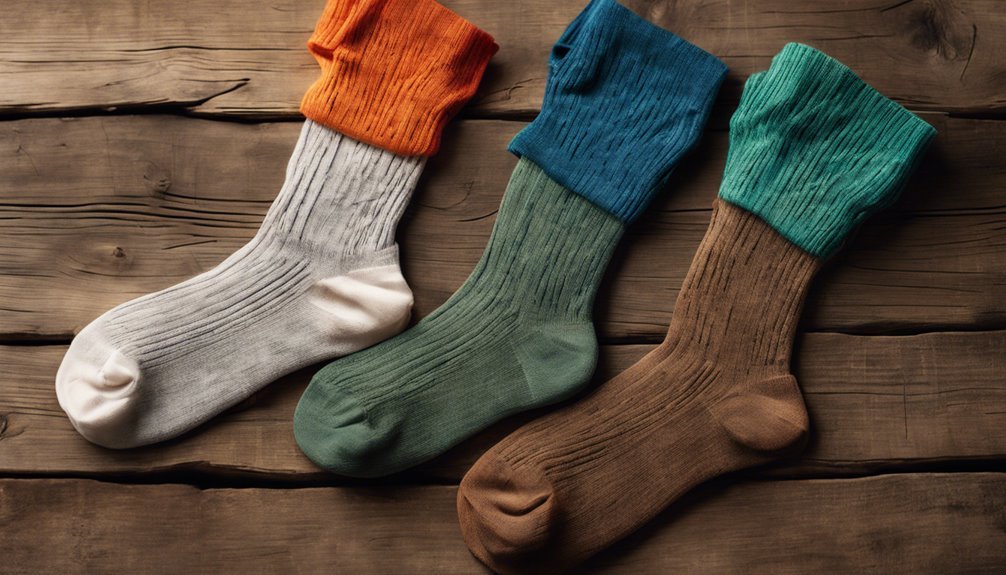
When you're out for a run or on a long hike, the last thing you want is to deal with unpleasant odors. That's where odor management techniques come into play. Running and hiking socks often incorporate specific materials and designs aimed at keeping your feet fresh. Look for socks with antimicrobial treatments, which help combat bacteria that cause odor. These treatments can greatly reduce the smell, allowing you to focus on your adventure instead of your feet. Additionally, moisture-wicking fabrics are key; they draw sweat away from your skin, minimizing dampness that can lead to odors. By choosing the right socks with these features, you can enjoy your freedom in the great outdoors without the worry of unwanted smells.
Price Range and Value
Finding the right price range for running and hiking socks can be vital for maximizing your outdoor experience without breaking the bank. When you're considering budget considerations, it's important to evaluate the value assessment of each sock type to guarantee you're getting the best for your money. Here's a quick guide to help:
- Basic Running Socks: $10 – $20
- Mid-Range Hiking Socks: $15 – $30
- Premium Running Socks: $20 – $40
- High-End Hiking Socks: $30 – $60
Investing a little more in quality socks can mean longer-lasting comfort and performance. Ultimately, think about your specific needs and choose socks that maximize your freedom in the great outdoors while aligning with your budget.
Frequently Asked Questions
Can I Use Running Socks for Hiking or Vice Versa?
You can use running socks for hiking, but they might lack the cushioning and materials needed for rugged terrain. Conversely, hiking socks often provide better moisture-wicking and support, enhancing comfort during long treks. Choose wisely!
How Often Should I Replace My Running or Hiking Socks?
Think of your socks like trusty companions on a journey; their longevity directly affects performance. Replace them every 300-500 miles or when you notice wear, ensuring your adventures remain comfortable and free from blisters.
Are There Specific Brands Recommended for Running or Hiking Socks?
When choosing socks, brands like Darn Tough and Balega offer excellent options. Look for moisture-wicking materials and ample cushioning to enhance your comfort and performance, ensuring your feet stay dry and supported during activities.
What Are the Best Colors for Running and Hiking Socks?
When choosing sock colors, consider your preferences for visibility and style. Bright colors enhance sock visibility during runs or hikes, while darker shades can hide dirt. Ultimately, pick what makes you feel comfortable and confident.
Can I Wash My Socks in Hot Water?
You can wash your socks in hot water, but it depends on the sock material. Always check the washing instructions; some materials might shrink or lose elasticity. For best results, follow the manufacturer's guidelines.

